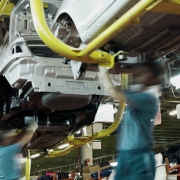In 2008 I was invited to a conference called Australia Recycles! in Fremantle. I flew coach for 30 hours (we had to divert, at one point, to Auckland instead of Sydney because huge headwinds used up more fuel than expected) and landed in Perth and then was driven to Freo by one of the conference organizers. (If you are keeping score at home, that’s 2.78 metric tons of carbon for the flight from Raleigh-Durham to Perth and back.)
It became clear that I was the “tethered goat,” brought in for entertainment and to spice things up a bit.
I had a day before my plenary address, and walked around the conference hall. Everyone there, everyone, represented either a municipal or provincial government, or a nonprofit recycling advocacy group, or a company that manufactured and sold complicated and expensive recycling equipment.
And what a wealth of machinery and equipment it was. Recycling requires substantial infrastructure for pickup, transportation, sorting, cleaning, and processing. I have sometimes suggested a test for whether something is garbage or a valuable commodity. Hold it in your hand, or hold a cup of it, or tank, or however you can handle it. Consider: Will someone pay me for this? If the answer is yes, it’s a commodity, a valuable resource. If the answer is no, meaning you have to pay them to take it, then it’s garbage.
It’s useful to pause for a moment and consider some definitions.
Is Recycling Useful, or Is It Garbage?
The problem with recycling is that people can’t decide which of two things is really going on.
- One possibility is that recycling transforms garbage into a commodity. If that’s true, then the price of pickup, transport, sorting, cleaning, and processing can be paid out of the proceeds, with something left over. That’s how it is with real commodities, such as wheat or pork bellies, after all. It’s expensive and complicated to produce wheat or pork bellies, and then deliver them to the market in a form that they can be used. But people will pay you for the wheat or pork bellies. In fact, the “profit test” shows that people will pay you enough to cover all those costs and still have something left over.
- The other possibility, and it’s a completely different possibility, is that recycling isn’t a commodity at all. But it is a cheaper or more environmentally friendly way to dispose of garbage. After all, if you bury something in a landfill, it’s gone. And you still had to collect it, transport it, and process it into the landfill. Recycling might cost money, but if you can sell the stuff for any price you are getting some of those costs back. Further, recycling keeps things out of landfills, and we systematically underprice landfill space. The reason is that we don’t want people dumping garbage in vacant lots or by the side of the road. But that means that recycling may be cheaper, all things considered, than using the space in the landfill. The problem is that “all things considered.” You really do have to add up all the costs — resources, money, convenience, environmental damage — of landfilling, and recycling, and then compare them.
These arguments are often muddled and mixed together, by both proponents and critics. And “recycling” is, after all, not just one homogeneous activity, but a whole collection of possible streams of waste or resources, each of which has to be evaluated separately. Should we recycle aluminum cans? Probably, because the price of recycling aluminum compares very favorably to using virgin materials, the mining and smelting of which are expensive in terms of energy and harmful to the environment.
Should we recycle toilet paper? We could, at some price. But it’s likely not worth it, because it can be composted, it would be awfully hard to clean and sort, and in any case paper products are actually a renewable resource, rather like wheat. You rarely hear someone saying, “Save the wheat! Give up bread!” But that kind of argument is often made for paper, even though the trees grown to produce pulp are simply a fast-growing crop grown on farms expressly for that purpose.
For recycling to be a socially commendable activity, it has to pass one of two tests: the profit test, or the net environmental-savings test. If something passes the profit test, it’s likely already being done. People are already recycling gold or other commodities from the waste stream, if the costs of doing so are less than the amount for which the resource can be sold.
Voluntary “recycling” like scrap iron or aluminum businesses will take care of that on their own. The real question arises with mandatory recycling programs — people recycle because they will be fined if they don’t, not because they expect to make money—or “voluntary” recycling programs such as those at universities or other communities where failure to recycle earns you public shaming.
For coercive or social-pressure recycling to make sense, three things have to be true.
- Scale. You need substantial amounts of the “input,” or garbage. Hauling small amounts is wasteful. Many suburban neighborhoods in the U.S. have small amounts of recycling out by the curb, and fossil fuel–powered trucks come by spewing greenhouse gases. Part of the reason wheat and pork bellies are valuable is that the average costs of transport and handling are low, because the scale is so large. I once watched a young woman in Vitacura, Chile, wait in line in her idling auto for more than 10 minutes so she could park and put two two-liter plastic bottles into a recycle bin. That’s not economics, that’s a religious ceremony. Without scale, most recycling harms the environment.
- Convenience. There is one resource we can’t get more of: time. Our lives pass quickly, and we have many things to do. But we are asked to donate our time to recycling, to “save” resources. We are asked to wash out and clean the stuff (I actually know people who run their garbage through the dishwasher, so it will be clean. Think of the time, coal-produced electricity, and hot water that uses.) Then we are supposed to sort the garbage and deliver it to the recycling facility.
Why isn’t this done at the recycling facility? Because the government realizes (correctly) it is too expensive, and the costs would swamp the tiny savings, if there are any, in doing recycling in the first place. But if the costs of cleaning and sorting are too great at scale, with commercial resources, why isn’t the sum of the individual costs of cleaning and sorting, in each household, even greater?
If you add up the time being wasted on recycling rituals, it’s even more expensive to ask each household to do it. The difference is that this is an implicit tax, a donation required of citizens, and doesn’t cost money from the public budget. But time is the least renewable of all resources; demanding that it be donated to a pointless or even harmful ritual such as recycling glass is government malpractice.
- Environmental savings. For recycling to make any sense, it must cost less to dispose of recycled material than to put the stuff in a landfill. But we have plenty of landfill space, in most of the country. And much of the heaviest material we want to recycle, particularly glass, is chemically inert and will not decompose in a landfill.
Ground “recycled” glass, or “cullet,” is less useful than the virgin silica sand from which glass is made. Cullet has impurities and chemical colorings that make it difficult to use for glass without further processing. To be clear, then: landfilling glass does no environmental harm, and the glass is more expensive than the virgin material it is supposed to replace. Further, glass is heavy, and carting it to distant processing centers, in any but the most urban areas, pollutes the air.
So, is recycling useful? As I said at the outset, for some things it is. Aluminum cans and corrugated cardboard, if they can be collected clean and at scale, are highly recyclable. I myself, on finding an aluminum can in the garbage, will generally take it out and try to find a recycle bin. It seems dumb to waste the aluminum, even though the value of the aluminum in one can is less than 2 cents.
But for most other things, recycling harms the environment. I’m not (just) saying it’s costly. I’m saying recycling is harmful. If you care about the environment, you should put your bottles and other glass in the regular garbage, every time.
This is now truer than ever. But it was also true back in 2008, when I visited Australia. And that was the case I tried to make. Let me go back and tell the rest of that story.
Tethered Goat
Remember, this was a conference for recycling advocates and manufacturers of recycling equipment, from around the Pacific Rim.
I was going to argue that there were economic reasons, technical but clear, why glass recycling was not only prohibitively expensive but also harmful to the environment. It made me wonder why I had been invited, but I surmised that they wanted to have at least one tethered goat for target practice, to keep sharp in being able to advocate their position.
I gave the talk, and… Nothing. Some polite applause, a few desultory questions. And then people just drifted off. I tried to strike up a conversation with some people who were still in the hall, and I asked them why there was no controversy.
One fellow was perfectly forthcoming: “Oh, we all know it makes no sense to recycle glass. The economic case is easy. But people should still recycle, because it’s simply the right thing to do. It’s not about the actual environment. It’s about enlisting people to care about the symbol of the environment. Overall, recycling is still worth doing, regardless of its effects.”
A young woman piped up: “It’s okay to say that sort of thing here, because we are insiders. But it’s better not to talk about the economics of things to the general public. We need to help train them to care about the environment, and recycling is one of the best ways to do that.”
I had heard something like this before, as I discussed in the 2007 article that likely got me the conference invite in the first place. An earnest young woman, the public spokesperson for the waste and recycling agency of a medium-sized town in the northeastern U.S. had told me breezily, “Oh, you have to understand: recycling is always cheaper, no matter how much it costs.” Oh, my.
The message I had worried about, and expected to be controversial, was old hat to the industry folks. But it was beside the point, because recycling was for them a moral imperative. Once you begin to think of recycling as a symbol of religious devotion rather than a pragmatic solution to environmental problems, the whole thing makes more sense.
As in any religious ceremony, the whole point is sacrifice: Abraham was ready to slay Isaac; Catholics give up meat during Lent; Muslims fast all day during Ramadan. And a young woman in Chile with two two-liter bottles sits in her car in line, knowing she is publicly visible and that her green moral virtue is apparent to everyone.
But lately the cost of the symbolic act of recycling, particularly for glass, has simply gotten too large. Cities and other local units were willing for a long time to sell their “customers” the chance to feel good about themselves, as long as the costs were reasonable. Recently however there has been a general decline in recycled commodity prices, and glass recycling in particular has crashed.
The recycling-industrial complex has been reduced to arguing that recycling “creates jobs,” though of course that’s only useful if the jobs produce something useful for consumers or improve the environment.
The real problem, as I see it, is that the recycling industry is selling indulgences, giving people the moral license to pollute because “Hey, I recycle!” To the extent that a lot of recycling is harmful to the environment, this is a double whammy: recycling is largely fake, but it enables people to feel okay about doing other things that pollute.
That young woman, in Chile? She was waiting in that line at the wheel of a large SUV.
Michael Munger is Professor of Economics at Duke University and Senior Fellow of the American Institute for Economic Research.
Photo by Javier Huedo on Unsplash













